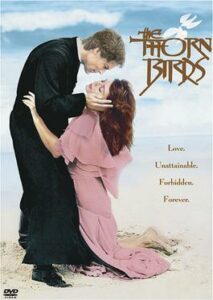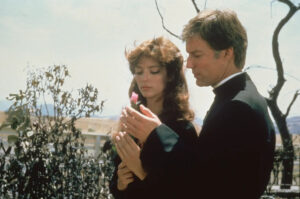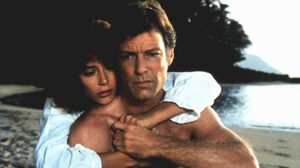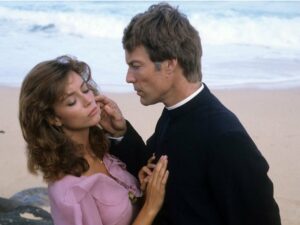“The Thorn Birds” – Every Rose Has It’s Thorns

Title: “The Thorn Birds”
Release Date: 1983
Director: Daryl Duke
Cast: Richard Chamberlain, Rachel Ward, Barbara Stanwyck, Christopher Plummer, Sydney Penny, Bryan Brown, Mare Winningham
The 1983 Golden Globe-winning miniseries “The Thorn Birds” directed by Daryl Duke, took the hearts of audiences around the world by storm. Based on the bestselling novel by Colleen McCullough, the story of forbidden love between Catholic priest Ralph and beautiful Meggie, despite the opposition of the Church, even in Poland gathered millions of viewers in front of TV sets. For the creators of the screen adaptation found the key to the hearts of the audience. It turned out to be wonderful actors, exotic Australian locations and a melodramatic story, the message of which is not to negate the traditional order, but to show the tragedy of unfulfilled love. And this one always carries similar emotions, no matter who the characters in the drama are. It also invariably becomes a story of redemption through suffering, which wounds like thorny rose bushes.
“The Thorn Birds” – From bestselling novel by Colleen McCullough to TV series
Australian author Colleen McCullough published “The Thorn Birds” in 1977. The book was published by the prestigious New York publishing house Harper & Row. Within seven years, 10.5 million copies of the novel were sold in the United States alone, and over the following decades it was published in dozens of countries. Without a doubt, Colleen McCullough has won the hearts of readers from all over the world. Interestingly, the writer, born in 1937, initially tied her future to medicine rather than literature. A native of Wellington, New South Wales, the author graduated from the University of Sydney and worked as a laboratory technician. She left Australia in the early 1960s, settling first in the UK and then in the US, where she headed the neurophysiology lab at Yale University. She made her debut as a writer in 1974 with the novel “Tim.”
In the early 1980s, Warner Bros. Television decided to produce a miniseries based on McCullough’s best-selling novel “The Thorn Birds”. Directing was entrusted to experienced filmmaker Daryl Duke. An excellent script was written by Carmen Culver, and Richard Chamberlain and Rachel Ward were cast in leading roles. The first episode of the series aired on ABC station on Palm Sunday, March 27, 1983. Of course, the production was an amazing success. It is worth mentioning that its popularity was unsuccessfully attempted to be repeated in 1996 by another series entitled “Birds of Thorns. The Missing Years” by Kevin James Dobson, but it had little in common with the original.

The series is set over several decades from 1915 to 1969. It is the story of several generations of the Cleary family and the associated Catholic clergyman Ralph de Bricassart. The main events are set in Australia. These include areas such as New South Wales, where the Drogheda estate is located, where Meggie’s family settles. Another setting is Queensland, where Meggie travels with her husband. And finally, the wonderful Matlock Island off the Great Barrier Reef, where Meggie spends the most beautiful moments of her life romancing Ralph. The series also features locations associated with de Bricassart’s church career: Sydney and, of course, the Vatican. Interestingly, the beautiful outdoor shots were not shot in Australia, but in California and on the Hawaiian island of Kaua. Nevertheless, the exotic scenery came off fabulously and, in addition to native Australians, delighted viewers around the world, adding to the charm of the entire production.
“The Thorn Birds” – sins of the Cleary family
“The Thorn Birds” in terms of genre is a combination of a family saga and a melodramatic romance. Over the course of several decades, we follow the story of the Cleary family: Paddy, his wife Fee (Jean Simmons) and their children, who come to Drogheda to live with the wealthy owner of the estate – Mary Carson (Barbara Stanwyck). Although Paddy is Mary’s brother, the insanely rich and spoiled woman has no intention of handing over the estate to him. For years in love and painfully spurned by the young priest Ralph, she devises a severe revenge against him: in her will she bequeaths Drogheda and £13 million to the Church, making the priest the executor of her will. In turn, he entrusts the lifetime management of the estate to his brother and his family.
Rev. Ralph, knowing that there are two versions of the will: one in which everything is inherited by the Clearych family and the other – allowing him a dazzling career in the church hierarchy, chooses the option favorable to his ambitions. In doing so, he rejects his immense affection for Meggie Cleary, the beautiful girl he has cared for since she came to Drogheda as a ten-year-old. The man leaves Australia to become a cardinal soon, and a distraught Meggie marries Luke O’Neill (Bryan Brown). The girl leaves with her husband for Queensland, where she has to work as a maid for the wealthy Mueller family, while her spouse is engaged in cutting sugar cane. A daughter, Justine, is born of the failed marriage. The paths of the unhappy Meggie and Cardinal Ralph cross again when he learns of the sad fate of his beloved. They meet on Matlock Island, where they experience an intoxicating romance. Afterwards, however, Ralph leaves for the Vatican, and Meggie and her daughter return to her hometown of Drogheda, where she bears the fruit of sinful love – a son Dane.

Thus, the fatalistic pattern of forbidden love is repeated in the Clearych family. For in the past, Meggie’s mother, Fee, also transgressed moral principles by entering into an affair with a married man, and from this love was born her beloved son Frank. However, fate “punished” the woman by taking Frank away from her, who died in prison convicted of murder. Meggie will also come to pay a heavy price for her sin: Dane, who decides to become a priest and spend several years under Ralph’s care at the Vatican, will drown at sea while trying to save two girls. Also gone will be Ralph, who, crushed by the news that he has outlived his life, not knowing that he has a son, will die in the rose garden in Meggie’s arms. Eventually, however, there will be a reconciliation between the women in the Clearych family: Meggie will forgive her mother’s aloofness, and her daughter Justine will learn that she was loved by her mother after all, and will be blessed to live together with a German diplomat.
“The Thorn Birds” – Christian free will or ancient fate?
“The Thorn Birds” operates with expressive symbolism that reveals the meanings inherent in the various elements of space-time. Here we have a clear contrast between the sphere of culture and spirituality, represented by the City and the Vatican’s St. Peter’s Cathedral, and the space of exotic Australian nature. The former is the order of reason and morality: within the walls of the magnificent cathedral, Father Ralph is always devoting himself to prayer, philosophical meditation and disputation with his spiritual mentor, Archbishop Vittorio (Christopher Plummer). Nature, on the other hand, represents unbridled human passion, which often takes precedence over reason and the obligations of his vows (priestly vows and the bonds of marriage).
Nevertheless, if one takes a closer look at both of these spaces – they turn out to be internally heterogeneous. This is because the sphere of culture and spirituality clearly breaks down here into two orders: the Judeo-Christian and the more primordial – ancient. Ralph and Vittorio marvel at Greek theater and repeatedly discuss the differences between the ancient Greek worldview and the Catholic vision. In the former, human fate is governed by fate, in the latter by individual free will.
The oscillation between these visions also exists within the natural space. South Wales, with its perpetually dry land, severe fires and monsoon floods, resembles an image of hell. The series of tragic events experienced by the Clearych family there also corresponds to this. Following this pattern, one might be tempted to interpret the space-time setting of Queensland in terms of purgatory: with its tropical whimsical climate, lush vegetation and palm trees coupled with the fate of Meggie, who, although hard working, finally experiences from the Muellers the love she never experienced as a child. And the gorgeous Matlock Island off the Great Barrier Reef is a magnificent paradise where the great dream of love finally comes true.

However, the categories drawn from Christian symbolism would overlap here with the ancient vision. For instead of development, we see the eternal return of things – time is not linear, but a circle: from the paradise island Meggie finds herself back in Drogheda. Similarly, the story of her family is also repeated – the children must pay for the sins of their mothers, so everything seems to be subordinated to fatalism. The movie also builds a clear parallel between the fate of the priest Ralph and the mythical Hippolytus, who rejected the favor of Phaedra, who fell in love with him. The fault of the ancient hero was that he refused to recognize that he was merely a weak man and succumbed to his true nature.
The same happens to Ralph, who for many years tells himself that he can fight his inner desires, and finally in Meggie’s arms confesses: “all I want is to be a man, I will never be anything else.” Therefore, we arrive at the structure of an ancient tragedy: the characters, despite the fact that they did not choose their fate, but were destined for each other, are guilty of transgressing moral principles and must be punished. We even have here the figure of “anagnorismos,” or “recognition,” typical of ancient tragedy, occurring just before the finale, when Ralph learns that Dane was his son.
“The Thorn Birds” – a dissertation on celibacy?
“The Thorn Birds” became famous as a controversial novel and series questioning the meaning of celibacy for priests. Nevertheless, as Grazyna Stachówna rightly points out, it is difficult to really find a deep polemic against the Catholic Church here. The movie does not attack at all the tradition existing since the 13th century related to the sexuality of the clergy. It does not make any universal arguments to refute celibacy. It shows a completely individual case of a man who misidentified his vocation. And this happened because his greatest weakness was his ambition to have a great career.

It is with her, and not with the love of God, that Ralph and Meggie’s love is lost. From the beginning, Father de Bricassart is a man who dreams of honor. Because of his disobedience, he is exiled to distant Australia, where he meets the wealthy Mary Carson. He rejects her advances, but at the same time accepts expensive gifts from her: a horse of noble blood and a car. He also can’t help but be tempted to take over the management of her estate, even though he has another option. Ralph does so, however, because it opens a straight path to the Vatican for him. As Stachówna very interestingly points out, it’s also worth noting that the issue of celibacy gets a broader development in “The Thorn Birds”: after all, there are more of these men choosing sexual abstinence in the series. These also include Meggie’s husband neglecting her for the colleagues she plays and works with, Meggie’s brothers who don’t bond with any woman, and Maggie’s son Dane.
The series “The Thorn Birds” – roses and thorns
An important leitmotiv of the film is the image of a rose garden. It is in it that the key scenes take place: the confession of love of a teenage girl, Meggie’s farewell to Ralph after the announcement of the will, and the death of the priest with his beloved at his feet. At the farewell, Meggie wounds herself with a rose thorn in her hand, and Ralph kisses the bloody wound with tenderness and passion. This is a scene with extraordinary erotic potential, foreshadowing the course of the entire story: sexual fulfillment will be paid for with great suffering. Ralph will take the rose he picked at the time and keep it for life as a beautiful memory of his beloved. Nevertheless, he will forget that it is a flower that can inflict wounds.
Corresponding with the rose motif is the title’s explanatory legend about the bird of the thorn bush, which the priest tells little Meggie. This bird sings only once in its life, when it finds a thorn bush. It is the most beautiful song, moving God himself, but paid with death – for the bird dies stabbed by a sharp thorn. Ralph explains to the girl the meaning of the story: we always pay for the most important things in life with great suffering. And so it happens with Meggie and Ralph: their forbidden love not only cannot be fulfilled, but is punished. And we take away authentic emotion from this story of a rose with sharp thorns, especially when accompanied by Henry Mancini’s wonderful music.
Literature:
G. Stachówna, „Róża i koloratka, czyli opowieść o zakazanej miłości. Ptaki ciernistych krzewów Colleeen McCullough i Daryla Duke’a”, [w:] “Od Banjo Patersona do Meliny Marchetty. Adaptacje literatury australijskiej”, pod red. A. Helman i M. Olszowskiej, Gdańsk 2017.
